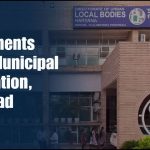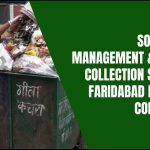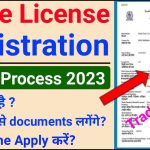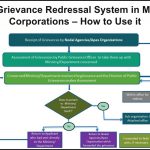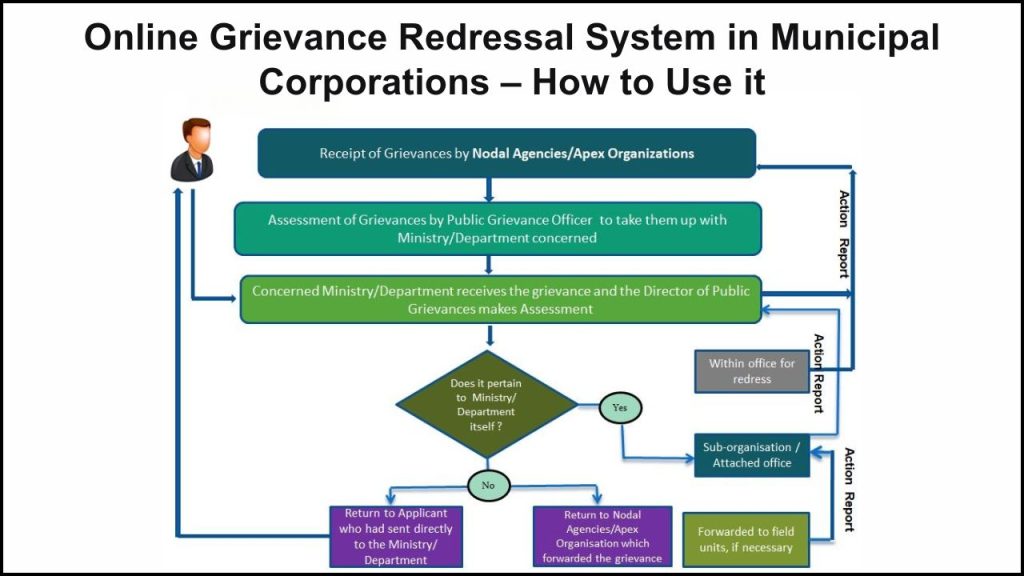
An online grievance redressal system provides a convenient platform for citizens to raise complaints regarding civic issues. It is the responsibility of Municipal corporations to handle key public services such as sanitation, street lighting, road maintenance, waste disposal, and water supply.
When problems occur in these areas, the online system allows individuals to lodge their concerns without physically visiting municipal offices. This initiative improves transparency, speeds up response time, and boosts public satisfaction. The adoption of such platforms is also in line with India’s broader Digital India mission, aiming to make governance more efficient and accessible.
Benefits of Online Grievance Redressal Systems
- Citizens get a quick and direct way to report civic problems
- Municipal officials receive real-time updates on complaints
- The system ensures a proper tracking mechanism
- Time taken for redressal reduces with online platforms
- Complaint status remains available to the complainant at all times
Common Issues Addressed Through the System
| Type of Grievance | Examples |
|---|---|
| Sanitation | Unclean roads, blocked drains, unattended garbage |
| Water Supply | Unclean roads, blocked drains, and unattended garbage |
| Street Lighting | Non-functional or broken street lights |
| Roads and Infrastructure | Potholes, broken footpaths, damaged speed breakers |
| Property Tax | Incorrect billing, payment issues |
| Birth and Death Certificates | Delay in issuance, correction errors |
| Building Permission | Approval delay, corruption allegations |
| Encroachments | Illegal constructions on public land |
| Stray Animal Issues | Increasing stray dogs, cows on roads |
Steps to Use the Online Grievance Redressal System
1. Accessing the Website or App
- The official website or mobile app of the local municipal corporation needs to be used
- Some cities also offer a centralized platform through state government portals
- Example: Delhi has “MCD App,” Mumbai has “MCGM Citizen Portal”
2. Registration or Login
- Registration using a mobile number or an email ID is necessary for most platforms
- One-Time Password (OTP) is used for verification
- Login credentials help in tracking complaint status
3. Selecting the Complaint Category
- Categories appear on the dashboard after login
- Correct category selection helps in routing the complaint to the right department
4. Providing Complaint Details
- The complaint description needs to be typed clearly
- The location of the issue must be mentioned
- Photos or videos can be uploaded for better understanding
5. Submitting the Complaint
- Complaint submission happens after filling in all required fields
- A unique complaint ID is generated after successful submission
- SMS or email notifications are sent as acknowledgment
6. Tracking the Complaint
- The Complaint ID is used to track the status
- The status may show terms like ‘Pending,’ ‘Under Process,’ or ‘Resolved’
7. Feedback and Closure
- Citizens can give feedback once the complaint is marked as resolved
- Dissatisfaction can be raised again for further action
General Flow of Complaint Handling
| Stage | Action |
|---|---|
| Complaint Registration | Citizen submits a complaint online |
| Complaint Routing | System forwards it to the correct department |
| Acknowledgment | Confirmation sent to the complainant |
| Investigation | The system forwards it to the correct department |
| Redressal | Action is taken by the department |
| Feedback | Citizen reviews the response |
| Closure | The officer visits the site or checks the problem |
Tips for Effective Use
- The complaint description must be simple and specific
- Use the correct address or geotag location
- Always upload supporting images if available
- Keep the complaint ID safe for tracking
- Avoid filing duplicate complaints for the same issue
- Refrain from using offensive or political language
Availability in Different Cities
| City | Platform Name | Access Medium |
|---|---|---|
| Delhi | MCD App | Mobile App |
| Mumbai | MCGM Citizen Portal | Website |
| Bengaluru | BBMP Sahaaya | Mobile App/Website |
| Hyderabad | GHMC Citizen App | Mobile App |
| Chennai | GCC Public Grievance Portal | Website |
| Pune | PMC Care | Mobile App/Website |
Government Support and Monitoring
- Central and state governments monitor the effectiveness of grievance portals
- Platforms are linked to service-level agreements (SLAs) that set time limits for redressal
- Regular dashboards are maintained to show resolution rates and pending issues
- Public feedback is analyzed for system improvements
Limitations and Challenges
- Internet access is still a challenge in rural areas
- Some platforms suffer from bugs or poor user experience
- A delay in action happens when departments lack coordination
- Language barriers affect those not fluent in English or the local language
- Repeated complaints without resolution may demotivate citizens
Improvements Suggested
- Mobile app performance needs enhancement for low-end phones
- Inclusion of voice-based complaint registration would help senior citizens
- Integration with WhatsApp or Telegram could improve accessibility
- Multi-language support will ensure inclusivity
- More staff training on digital platforms will ensure timely redressal
In Summary
Online grievance redressal systems are transforming the way citizens interact with municipal bodies. By offering a fast and efficient digital channel, these systems encourage greater accountability and faster resolution of public issues. Municipal corporations benefit through structured workflows and better public feedback. Continued technological improvements, along with greater awareness among citizens, can make these platforms even more effective. A well-informed and proactive citizenry is key to making governance more responsive and transparent.
